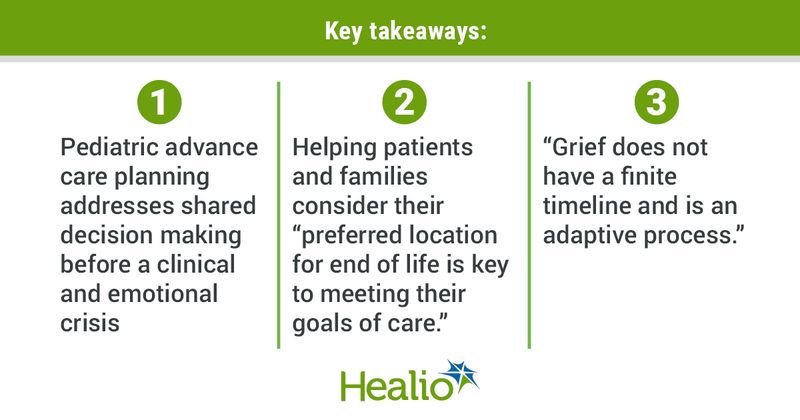AAP publishes guidance for pediatric end-of-life care
The AAP published guidelines for pediatric end-of-life care, including recommendations for communicating with families and for planning advance care.
The guidelines are in a clinical report authored by Jennifer S. Linebarger, MD, MPH, FAAP, Victoria Johnson, DO, FAAP, and Renee D. Boss, MD, MHS, FAAP, of the AAP’s Section on Hospice and Palliative Medicine.

“Some children and adolescents die unexpectedly and suddenly, and others die after years of serious illness,” they wrote. “Early advance care planning is beneficial, and the final days and weeks of life offer additional opportunities for shared decision making and revisiting goals of care.
“Familiarity with the medical, emotional, spiritual, and logistic elements of end-of-life care allows the pediatrician to be a comforting guide for these families. Collaboration with pediatric palliative care and hospice resources can support families and staff during pediatric end-of-life care.”
The report discusses elements of pediatric care for patients and their families, including the creation end-of-life care goals, anticipatory counseling about the dying process, expected signs or symptoms, code status, desired location of death and engagement with palliative and hospice resources.
“Tapping into the strength of the trusted longitudinal relationship provided by the medical home, particularly for those with medical complexity, benefits the patient and family, regardless of the location or circumstance surrounding the end of life,” they wrote. “Notably, when access to home-based pediatric hospice care is limited, the medical home may take a leading role in providing quality end-of-life care.”
The authors noted that the AAP recommends a specialty version of pediatric palliative care and that such a team “should be consulted for advanced clinical treatments and complicated decision-making and for social and spiritual needs beyond what the primary care team can provide,” and could help to “optimize complex pain and symptom care, quality of life, appraisal of prognosis, conversations about shifting goals, and family and care team support.”
In terms of communication, the authors recommended straightforward information provided in a coordinated and consistent matter that respects a family’s unique knowledge of their child, leaving time to ask questions, allowing ready access to staff members, and providing resources for addressing conflicting goals, among other recommendations.
They also suggested advance care planning “before a clinical and emotional crisis” with a comprehensive advance care plan that could include legal forms, medical orders or more informal planning.
The authors discussed family bereavement care, noting that the AAP has “emphasized that bereavement care should be standard of care for grieving families and is a public health priority.” While mentioning how families can feel a loss of connection to their “second family” of care professionals, they added that grief does not operate the same way for all.
“Grief does not have a finite timeline and is an adaptive process,” they wrote. “Bereavement supports provided by hospices typically end after 1 year, although families likely continue to need support for years to come.”
The authors ended by noting that a grieving family’s “familiarity with the medical, emotional, spiritual, and logistic elements of end-of-life care allows the pediatrician to be a comforting guide for these families.”
“Collaboration with pediatric palliative care and hospice resources can support families and staff during pediatric end-of-life care,” they wrote.
